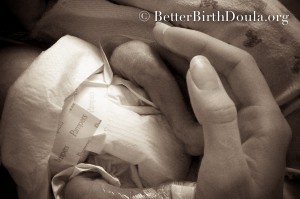 Entering the NICU is like entering another world, and it can be an emotionally jarring experience for anyone - even more so when it is your infant. Whether parents were anticipating an early arrival and NICU stay or if they were birthing a full term baby and surprised by complications, the NICU is an overwhelming and terrifying place. When a healthy baby arrives everyone is quick to grab the camera and snap photos to share - when a baby arrives prematurely or with complications at term there is often a rush for immediate medical care and photos are forgotten. Though it is scary, once things have stabilized then photos of these first moments and days of every baby's life are important to capture.
Entering the NICU is like entering another world, and it can be an emotionally jarring experience for anyone - even more so when it is your infant. Whether parents were anticipating an early arrival and NICU stay or if they were birthing a full term baby and surprised by complications, the NICU is an overwhelming and terrifying place. When a healthy baby arrives everyone is quick to grab the camera and snap photos to share - when a baby arrives prematurely or with complications at term there is often a rush for immediate medical care and photos are forgotten. Though it is scary, once things have stabilized then photos of these first moments and days of every baby's life are important to capture.
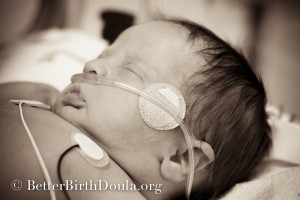 If you are a doula or photographer at a birth and there are complications then be incredibly careful with taking photos - hospital staff may ask you to stop, and their attention needs to be completely focused on the baby so do not interrupt them to ask for permission! Once things have calmed down then you can quietly ask if it's okay to take pictures. If the baby is transported immediately to the NICU then you generally cannot follow, and once the baby is settled into their new spot the partner will be invited to come in. As a guest you may or may not be able to also come and take pictures. These can be wonderful to share with mom if she's not able to get up and see the baby herself, so it's worth asking if you can come with to take those pictures. If not be sure the partner/dad, if he feels up to it, takes a camera into the NICU.
If you are a doula or photographer at a birth and there are complications then be incredibly careful with taking photos - hospital staff may ask you to stop, and their attention needs to be completely focused on the baby so do not interrupt them to ask for permission! Once things have calmed down then you can quietly ask if it's okay to take pictures. If the baby is transported immediately to the NICU then you generally cannot follow, and once the baby is settled into their new spot the partner will be invited to come in. As a guest you may or may not be able to also come and take pictures. These can be wonderful to share with mom if she's not able to get up and see the baby herself, so it's worth asking if you can come with to take those pictures. If not be sure the partner/dad, if he feels up to it, takes a camera into the NICU.
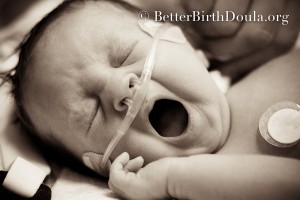 When entering the ICU you'll need to take off any jewelry on your hands and wrists, pull your sleeves up and scrub for about 3 minutes. Some NICUs even have a timer for you and special sinks with pedals so you won't touch anything after washing. Just minimize whatever jewelry you wear in to make it easier. Obviously you'll also be carrying and touching a camera bag after you scrub, so be careful you do not touch any of the baby's items or the baby. If you are able to move things around and want something changed (a blanket shifted out of the way, for example) then ask the parents to handle it so you're not exposing the baby inadvertently. There's hand sanitizer inside the unit as well - use it!
When entering the ICU you'll need to take off any jewelry on your hands and wrists, pull your sleeves up and scrub for about 3 minutes. Some NICUs even have a timer for you and special sinks with pedals so you won't touch anything after washing. Just minimize whatever jewelry you wear in to make it easier. Obviously you'll also be carrying and touching a camera bag after you scrub, so be careful you do not touch any of the baby's items or the baby. If you are able to move things around and want something changed (a blanket shifted out of the way, for example) then ask the parents to handle it so you're not exposing the baby inadvertently. There's hand sanitizer inside the unit as well - use it!
Seeing critically ill and extremely premature infants is a very startling experience. It may help if you prepare yourself by viewing images of preemies online before you go. Friends and family are often unsure of what to say in such a situation and can become overwhelmed and emotional. That's okay - I don't think any visitor to meet our preemie saw him without crying! It let us know how much they cared, but also be careful that the parents don't feel they need to comfort you. Pack some tissue in your pocket and smile through your tears! Tell them congratulations. So often these parents are hearing, "I'm so sorry!" which is also appropriate, but make sure you also congratulation them on their new arrival. When in doubt it's wise to stick with, "Congratulations! Your baby is beautiful." Comment on similarities between parent and child, ask about the baby's name, tell them they will be in your thoughts and prayers, or whatever you feel is appropriate.
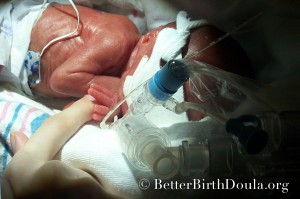 If you've not attended the birth but are going later for pictures then be sure to ask about scheduling. Babies are often given set times to be changed, fed, and held. Depending on the baby's condition the parents may be able to hold the baby during feedings or do kangaroo (skin-to-skin) care and these can be beautiful times to get pictures. If the baby is not able to be held then you can still take photos of the parents touching their baby, holding hands, stroking their head, and giving a size comparison - the baby's arm to mom's finger! If possible it's nice to be there for the first time the baby is held or even the first time dad is able to touch his child if the baby isn't able to be held just yet.
If you've not attended the birth but are going later for pictures then be sure to ask about scheduling. Babies are often given set times to be changed, fed, and held. Depending on the baby's condition the parents may be able to hold the baby during feedings or do kangaroo (skin-to-skin) care and these can be beautiful times to get pictures. If the baby is not able to be held then you can still take photos of the parents touching their baby, holding hands, stroking their head, and giving a size comparison - the baby's arm to mom's finger! If possible it's nice to be there for the first time the baby is held or even the first time dad is able to touch his child if the baby isn't able to be held just yet.
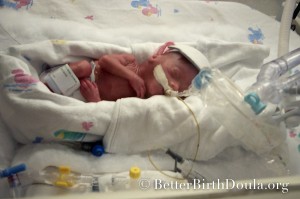 It can be tricky when the baby is in the isolette as you'll be dealing with glare on the plastic case. The staff may be able to lift the lid for a moment to let you capture a picture, but you may need to just try for the best spot to minimize reflection and glare. If the baby is under special lights then the baby will often be wearing protective eye shades, which they may be able to remove quickly and turn off the lights to allow you a photo of the baby's face. In either case there is usually enough bright lights under the baby's warmer that no flash is necessary - do not use a flash in the NICU. Certainly not without asking, but ideally do not use one at all. Preemie babies are incredibly sensitive to lights and noise and it can be jarring for them - even more so than with a term newborn. When a preemie is unstable it's even more crucial that they not be startled, as tiny stressors like that can have big impacts on their heart rate, respiration, and thus their oxygen saturation and stability. Many cameras are not able to handle indoor photos without flash and parents will do the best with whatever they have, but this is when your low aperture lens (50mm f1.8 on Canon or 35mm f1.8 Nikon are inexpensive options) will come in so handy at getting beautiful low light shots.
It can be tricky when the baby is in the isolette as you'll be dealing with glare on the plastic case. The staff may be able to lift the lid for a moment to let you capture a picture, but you may need to just try for the best spot to minimize reflection and glare. If the baby is under special lights then the baby will often be wearing protective eye shades, which they may be able to remove quickly and turn off the lights to allow you a photo of the baby's face. In either case there is usually enough bright lights under the baby's warmer that no flash is necessary - do not use a flash in the NICU. Certainly not without asking, but ideally do not use one at all. Preemie babies are incredibly sensitive to lights and noise and it can be jarring for them - even more so than with a term newborn. When a preemie is unstable it's even more crucial that they not be startled, as tiny stressors like that can have big impacts on their heart rate, respiration, and thus their oxygen saturation and stability. Many cameras are not able to handle indoor photos without flash and parents will do the best with whatever they have, but this is when your low aperture lens (50mm f1.8 on Canon or 35mm f1.8 Nikon are inexpensive options) will come in so handy at getting beautiful low light shots.
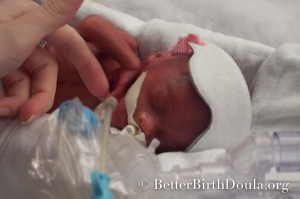 When you enter the NICU check for your lighting source. Most are very well lit with overhead florescent lights. Some have excellent window lighting, others will keep the blinds closed. Play around with which spot gives you the nicest lit shot. I won't give specific setting tips as that will vary so drastically from one hospital to the next. But standard birth ideas apply - increase your ISO, drop your aperture, and unlike birth shots you can have a longer shutter speed as babies in their incubators don't move much! Depending on room size you may even be allowed to bring in a tripod to steady you. While it's handy to lean on things to use your arms as a tripod for stability, be careful what you lean on or against in the NICU! Much of the medical equipment (ventilators, IV stands, beds) are on wheels and will slide away from you - dangerous for you and baby!
When you enter the NICU check for your lighting source. Most are very well lit with overhead florescent lights. Some have excellent window lighting, others will keep the blinds closed. Play around with which spot gives you the nicest lit shot. I won't give specific setting tips as that will vary so drastically from one hospital to the next. But standard birth ideas apply - increase your ISO, drop your aperture, and unlike birth shots you can have a longer shutter speed as babies in their incubators don't move much! Depending on room size you may even be allowed to bring in a tripod to steady you. While it's handy to lean on things to use your arms as a tripod for stability, be careful what you lean on or against in the NICU! Much of the medical equipment (ventilators, IV stands, beds) are on wheels and will slide away from you - dangerous for you and baby!
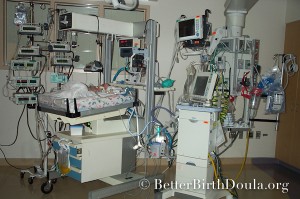 Despite the vast array of equipment surrounding them, beneath it all is a beautiful baby. It's good to capture some photos from further back that convey the setting, but be sure to get some tight shots. NICU visitors are generally very restricted so the new parents aren't able to show off their baby to friends and family. Photos allow them to introduce their little one to everyone eager to meet them, so be sure to get pictures that focus on the baby's personality - the yawns, the stretches, the cute cheeks, the tiny toes, and the hair.
Despite the vast array of equipment surrounding them, beneath it all is a beautiful baby. It's good to capture some photos from further back that convey the setting, but be sure to get some tight shots. NICU visitors are generally very restricted so the new parents aren't able to show off their baby to friends and family. Photos allow them to introduce their little one to everyone eager to meet them, so be sure to get pictures that focus on the baby's personality - the yawns, the stretches, the cute cheeks, the tiny toes, and the hair.
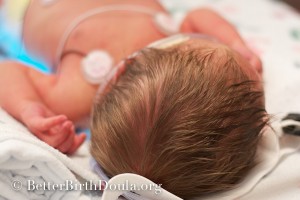 With births I generally put photos in a black & white, as there are a lot of distracting colors (not all flattering) in a birth. With the NICU it's nice to do some images in black and white still, which helps to focus on the baby and soften the multi-colored tubes and wires attached to them. Preemies may have incredibly red skin, jaundiced babies may be very yellow, and the black and white can be less visually startling. But be sure to do some in color, as those are also the details that fade from memory and are parts of their story. My preemie now thinks it's funny to see how incredibly red he was when he arrived 17 weeks too early!
With births I generally put photos in a black & white, as there are a lot of distracting colors (not all flattering) in a birth. With the NICU it's nice to do some images in black and white still, which helps to focus on the baby and soften the multi-colored tubes and wires attached to them. Preemies may have incredibly red skin, jaundiced babies may be very yellow, and the black and white can be less visually startling. But be sure to do some in color, as those are also the details that fade from memory and are parts of their story. My preemie now thinks it's funny to see how incredibly red he was when he arrived 17 weeks too early!
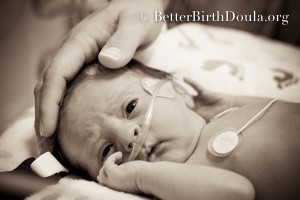 If the baby is not stable enough to hold then you can bring a dark, solid colored blanket or sheet and ask if the parents may lift the baby up and spread the blanket underneath. This can help hide some of the equipment and also give you a nice background for photos. Be sure to ask, as you may need the nurse's assistance to ensure you don't disconnect anything important. Many babies in the NICU are unable to wear clothes as they cannot control their body temperature yet and will be under warmer lights. When doing kangaroo care they will be skin-to-skin the parents' chest and covered in blankets. This is another time that a solid colored blanket is nice, or any blanket meaningful to the parents such as a gift blanket. If mom is doing kangaroo care she may want to wear an unobtrusive bra or tank top for the photo shoot so she's not uncomfortable being exposed in any of the images. It's also helpful if the parents wear dark, solid colored shirts.
If the baby is not stable enough to hold then you can bring a dark, solid colored blanket or sheet and ask if the parents may lift the baby up and spread the blanket underneath. This can help hide some of the equipment and also give you a nice background for photos. Be sure to ask, as you may need the nurse's assistance to ensure you don't disconnect anything important. Many babies in the NICU are unable to wear clothes as they cannot control their body temperature yet and will be under warmer lights. When doing kangaroo care they will be skin-to-skin the parents' chest and covered in blankets. This is another time that a solid colored blanket is nice, or any blanket meaningful to the parents such as a gift blanket. If mom is doing kangaroo care she may want to wear an unobtrusive bra or tank top for the photo shoot so she's not uncomfortable being exposed in any of the images. It's also helpful if the parents wear dark, solid colored shirts.
 In some cases you may not be able to use any of these tips, as the tiny baby is too unstable to be moved at all. In those situations it's even more important that capture anything that you can. When we were unsure how long our son would be with us, hearing that his chance of survival was so low, we took tons of photos every single day. We also wanted video to capture the sounds of the NICU - the loud ventilator wooshing & beeping of alarms. But be cautious about noise while you are in there - again, these little ones need as much peace and quiet as possible while they are resting and growing. The exception being parents talking to their little one, as they've found babies recognize their parents' voices and that can be soothing and reassuring.
In some cases you may not be able to use any of these tips, as the tiny baby is too unstable to be moved at all. In those situations it's even more important that capture anything that you can. When we were unsure how long our son would be with us, hearing that his chance of survival was so low, we took tons of photos every single day. We also wanted video to capture the sounds of the NICU - the loud ventilator wooshing & beeping of alarms. But be cautious about noise while you are in there - again, these little ones need as much peace and quiet as possible while they are resting and growing. The exception being parents talking to their little one, as they've found babies recognize their parents' voices and that can be soothing and reassuring.
When doing a NICU shoot I suggest providing all of the images to parents in color and black & white, full sized. If you are able to host them in a private gallery this can be a huge blessing to parents, as they want to share photos with loved ones far away. There are professional photographer organizations which provide free NICU shoots to families such as the American Child Photographers Charity Guild. For parents experiencing the loss of a child from 25 weeks on there is Now I Lay Me Down to Sleep. (Though I'm not sure why they specify 25 weeks - I will ask them!)
Photos may be the last thing on a parent's mind when their child is born premature or with health complications, but if you are in a position to offer to take photos then go for it!
Images are my 23 week preemie and a full term baby with medical complications - my thanks to the parents for letting me share!

One Response to NICU Photography Tips | Denton Birth Photography